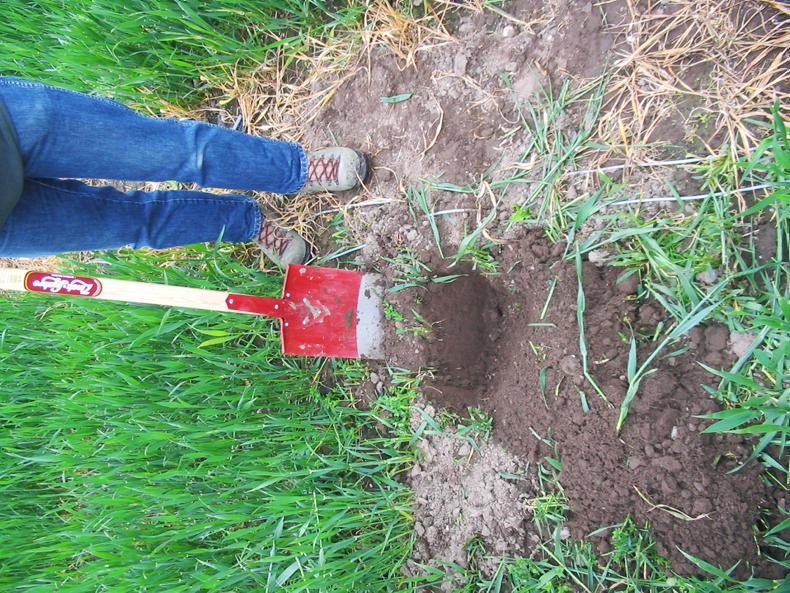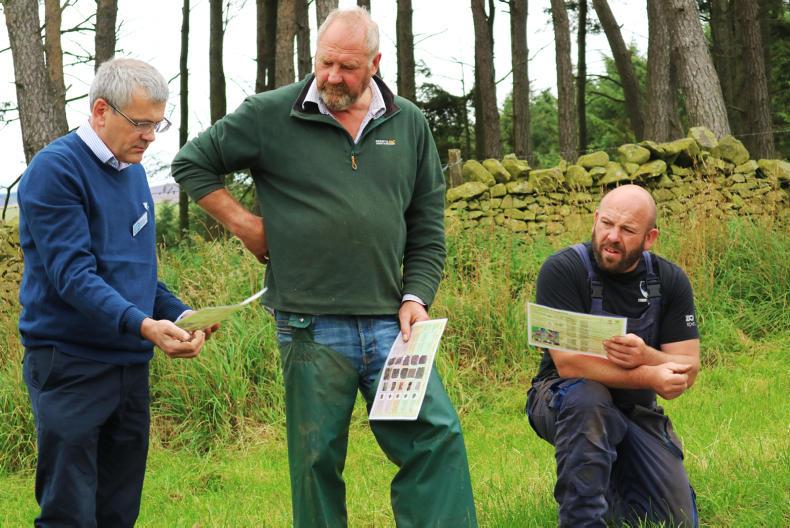Decide where to sample
Pick problem areas in the field. Don’t do a random W-shape as you would when soil sampling. It may be worth picking a spot close to the edge of the field where you know there has not been much traffic just by way of comparison. Aim for 10 or more spots. Sampling can be done at any time of year but preferably when the soil is moist. If the soil is too dry or too wet, it can be difficult to obtain a representative sample. Roots are best seen in an established crop or for some months after harvest.
Dig out a piece of soil
Ideally, the soil you dig out should be the depth and width of a spade. Make it as intact a block as possible so that you can open it up and see what it’s like. Place the spade, with the soil, on to a sheet or the ground. When deciding where to sample, you should select an area of uniform crop, soil colour or an area where you suspect there may be a problem. Within this area, plan a grid to look at the soil at 10 or more spots. On smaller plots, three to five spots may do.
Examine the block
Firstly, assess the colour and smell of the soil (good soil won’t smell sour). If the block has a uniform structure remove any compacted soil or debris from around the block. If it has two or more horizontal layers of differing structure, estimate the depth of each layer and analyse separately.
Break up the block
Gently pull the block apart to reveal any cohesive layers or clumps of aggregates. If possible, separate natural aggregates and man-made clods (large, hard, cohesive and rounded aggregates). Break larger pieces apart into aggregates of 1.5cm to 2cm. Look at their shape, porosity, roots and ease of breakup. Clods can be broken into non-porous aggregates with angular corners and are indicative of poor structure.
Scoring – assign a structure quality score
to each sample
SQ 1 – friable: aggregates crumble readily with fingers. They are mostly less than 6mm after crumbling, with roots throughout the soil.SQ2 – intact: aggregates are easy to break with one hand. There is a mixture of porous rounded aggregates from 2mm to 7cm, with roots throughout the soil.SQ3 – firm: most aggregates break with one hand. A mixture of porous aggregates from 2mm to 10cm (less than 30% are under 1cm). Some angular, non-porous clods may be present. Porosity and roots exist within aggregates.SQ4 – compact: requires considerable effort to break aggregates with one hand. It is mostly large (at least 10cm), sub-angular and non-porous. Horizontal /platy is also possible. Less than 30% are under 7cm. All roots are clustered in macropores and around aggregates.SQ5 – very compact: mostly large (at least 10cm); very few are less than 7cm; angular and non-porous. There are few roots and, if any, they are restricted to cracks. There are many factors that may increase the score such as difficulty extracting the block; the shape and size of aggregates; the clustering, thickening and deflections of roots; and the presence of pockets or layers of grey soil. Scores of one to three are usually acceptable but scores of four to five require management changes such as soil loosening. The spit of soil may contain a compact layer of poorer quality soil. Target this layer for any improvement. Scotland’s Rural College (SRUC) led the development of this VESS test. Details are available at http://www.sruc.ac.uk/vess
Decide where to sample
Pick problem areas in the field. Don’t do a random W-shape as you would when soil sampling. It may be worth picking a spot close to the edge of the field where you know there has not been much traffic just by way of comparison. Aim for 10 or more spots. Sampling can be done at any time of year but preferably when the soil is moist. If the soil is too dry or too wet, it can be difficult to obtain a representative sample. Roots are best seen in an established crop or for some months after harvest.
Dig out a piece of soil
Ideally, the soil you dig out should be the depth and width of a spade. Make it as intact a block as possible so that you can open it up and see what it’s like. Place the spade, with the soil, on to a sheet or the ground. When deciding where to sample, you should select an area of uniform crop, soil colour or an area where you suspect there may be a problem. Within this area, plan a grid to look at the soil at 10 or more spots. On smaller plots, three to five spots may do.
Examine the block
Firstly, assess the colour and smell of the soil (good soil won’t smell sour). If the block has a uniform structure remove any compacted soil or debris from around the block. If it has two or more horizontal layers of differing structure, estimate the depth of each layer and analyse separately.
Break up the block
Gently pull the block apart to reveal any cohesive layers or clumps of aggregates. If possible, separate natural aggregates and man-made clods (large, hard, cohesive and rounded aggregates). Break larger pieces apart into aggregates of 1.5cm to 2cm. Look at their shape, porosity, roots and ease of breakup. Clods can be broken into non-porous aggregates with angular corners and are indicative of poor structure.
Scoring – assign a structure quality score
to each sample
SQ 1 – friable: aggregates crumble readily with fingers. They are mostly less than 6mm after crumbling, with roots throughout the soil.SQ2 – intact: aggregates are easy to break with one hand. There is a mixture of porous rounded aggregates from 2mm to 7cm, with roots throughout the soil.SQ3 – firm: most aggregates break with one hand. A mixture of porous aggregates from 2mm to 10cm (less than 30% are under 1cm). Some angular, non-porous clods may be present. Porosity and roots exist within aggregates.SQ4 – compact: requires considerable effort to break aggregates with one hand. It is mostly large (at least 10cm), sub-angular and non-porous. Horizontal /platy is also possible. Less than 30% are under 7cm. All roots are clustered in macropores and around aggregates.SQ5 – very compact: mostly large (at least 10cm); very few are less than 7cm; angular and non-porous. There are few roots and, if any, they are restricted to cracks. There are many factors that may increase the score such as difficulty extracting the block; the shape and size of aggregates; the clustering, thickening and deflections of roots; and the presence of pockets or layers of grey soil. Scores of one to three are usually acceptable but scores of four to five require management changes such as soil loosening. The spit of soil may contain a compact layer of poorer quality soil. Target this layer for any improvement. Scotland’s Rural College (SRUC) led the development of this VESS test. Details are available at http://www.sruc.ac.uk/vess


















SHARING OPTIONS